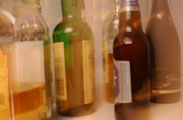 |
|
 |
 |
 |
Quick Stats
Binge Drinking

Binge drinking is a common pattern of excessive
alcohol use in the United States. The
National Institute of Alcohol Abuse and Alcoholism defines binge
drinking as a pattern of drinking that brings a person’s blood alcohol
concentration (BAC) to 0.08 grams percent or above. This typically happens
when men consume 5 or more drinks, and when women consume 4 or more drinks,
in about 2 hours.1
Most people who binge drink are not alcohol
dependent.
According to national surveys
- Approximately 92% of U.S. adults who drink excessively report binge
drinking in the past 30 days.2
- Although college students commonly binge drink, 70% of binge
drinking episodes involve adults over age 25 years.3
- The prevalence of binge drinking among men is 2 times the prevalence
among women.4
- Binge drinkers are 14 times more likely to report alcohol-impaired
driving than non-binge drinkers.3
- About 90% of the alcohol consumed by youth under the age of 21 years in
the United States is in the form of binge drinks.5
- About 75% of the alcohol consumed by adults in the United States is
in the form of binge drinks.5
- The proportion of current drinkers that binge is highest in the 18-
to 20-year-old group (51%).3
Binge drinking is associated with many health problems, including but not
limited to
- Unintentional injuries (e.g., car crashes, falls, burns, drowning).
- Intentional injuries (e.g., firearm injuries, sexual assault,
domestic violence).
- Alcohol poisoning.
- Sexually transmitted diseases.
- Unintended pregnancy.
- Children born
with Fetal Alcohol Spectrum Disorders.
- High blood pressure, stroke, and other cardiovascular diseases.
- Liver disease.
- Neurological damage.
- Sexual dysfunction.
- Poor control of diabetes.
Evidence-based interventions to prevent binge drinking and related harms6,7,8,9,10 include
- Increasing alcoholic beverage costs and excise taxes.
- Limiting the number of retail alcohol outlets that sell alcoholic
beverages in a given area.
- Consistent enforcement of laws against underage drinking and
alcohol-impaired driving.
- Screening and counseling for alcohol misuse.
References:
- National Institute of
Alcohol Abuse and Alcoholism. NIAAA council approves definition of binge
drinking. NIAAA
Newsletter 2004; No.
3, p. 3. Available at
http://pubs.niaaa.nih.gov/publications/Newsletter/winter2004/Newsletter_Number3.pdf
(PDF). Accessed March 31, 2008.
- Town M, Naimi TS, Mokdad AH,
Brewer RD.
Health care access among U.S.
adults who drink alcohol excessively: missed opportunities for
prevention.
Prev Chronic Dis
[serial online] April 2006. Accessed March 31, 2008.
- Naimi TS, Brewer RD, Mokdad
A, Clark D, Serdula MK, Marks JS.
Binge drinking among US adults.
JAMA
2003;289(1):70–75.
- Centers for Disease Control
and Prevention. Behavioral Risk Factor Surveillance System prevalence data.
Atlanta, GA: CDC. Available at
www.cdc.gov/brfss.
Accessed March 27, 2008.
- Office of Juvenile Justice
and Delinquency Prevention.
Drinking in America: Myths,
Realities, and Prevention Policy.
Washington, DC: U.S. Department of Justice, Office of Justice Programs,
Office of Juvenile Justice and Delinquency Prevention, 2005. Available
at
http://www.udetc.org/documents/Drinking_in_America.pdf*
(PDF). Accessed March 28, 2008.
- Babor TF, Caetano, R., Casswell S, et al. Alcohol and Public
Policy: No Ordinary Commodity. New York: Oxford University Press;
2003
- The Community Guide. Alcohol Abuse and Misuse Prevention.
Interventions Directed to the General Population. Atlanta, GA:
Centers for Disease Control and Prevention, 2008. Available at
http://www.thecommunityguide.org/alcohol/default.htm.* Date
accessed: May 9, 2008.
- National Research Council and Institute of Medicine. Reducing
Underage Drinking: A Collective Responsibility. Washington, DC:
National Academies Press; 2004.
- U.S. Department of Health and Human Services. The Surgeon General’s
Call to Action to Prevent and Reduce Underage Drinking. U.S. Department
of Health and Human Services, Office of the Surgeon General; 2007.
Available at
http://www.surgeongeneral.gov/topics/underagedrinking/. Accessed May
9, 2008.
- U.S. Preventive Services Task Force. Screening and behavioral
counseling interventions in primary care to reduce alcohol misuse:
recommendation statement. Ann Intern Med 2004;140:554–556.
* Links to non-Federal organizations are
provided solely as a service to our users. Links do not constitute an
endorsement of any organization by CDC or the Federal Government, and none
should be inferred. The CDC is not responsible for the content of the individual
organization Web pages found at this link.
One or more documents on this Web page is available in Portable Document Format
(PDF). You will need Acrobat
Reader to view and print these documents.
Page last reviewed: August 6, 2008
Page last modified: August 6, 2008
Content source: Division of Adult and Community Health,
National Center for Chronic Disease Prevention and
Health Promotion |
 |